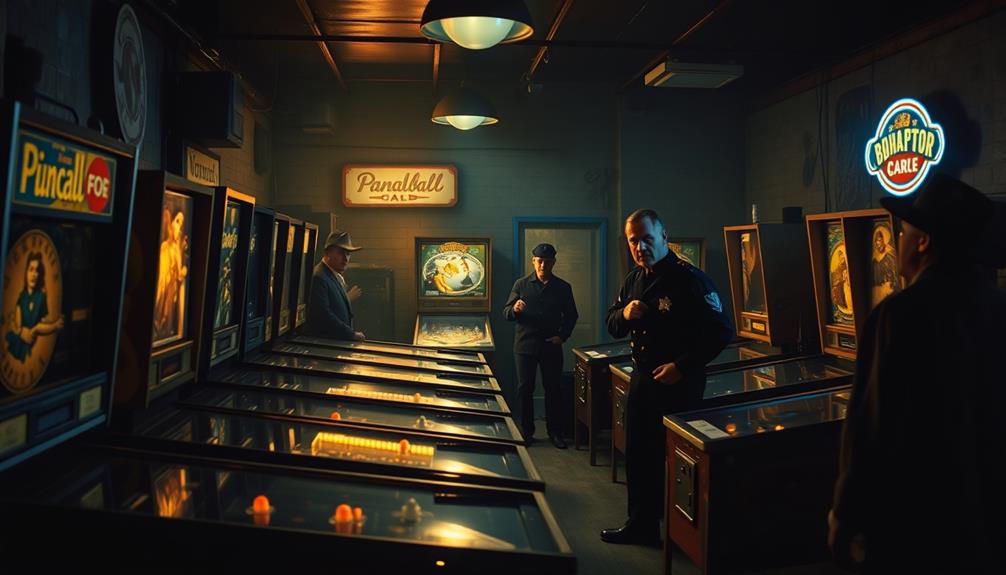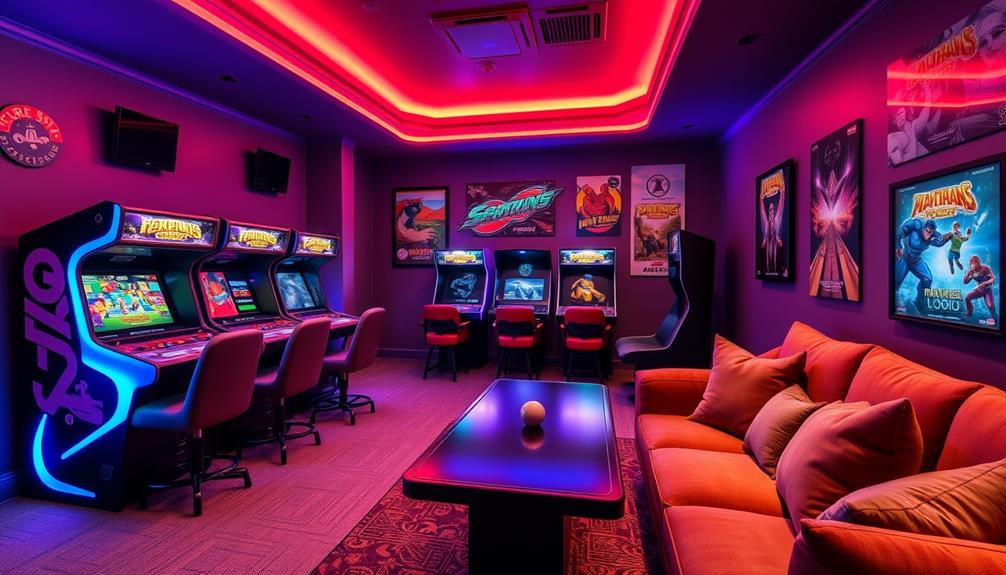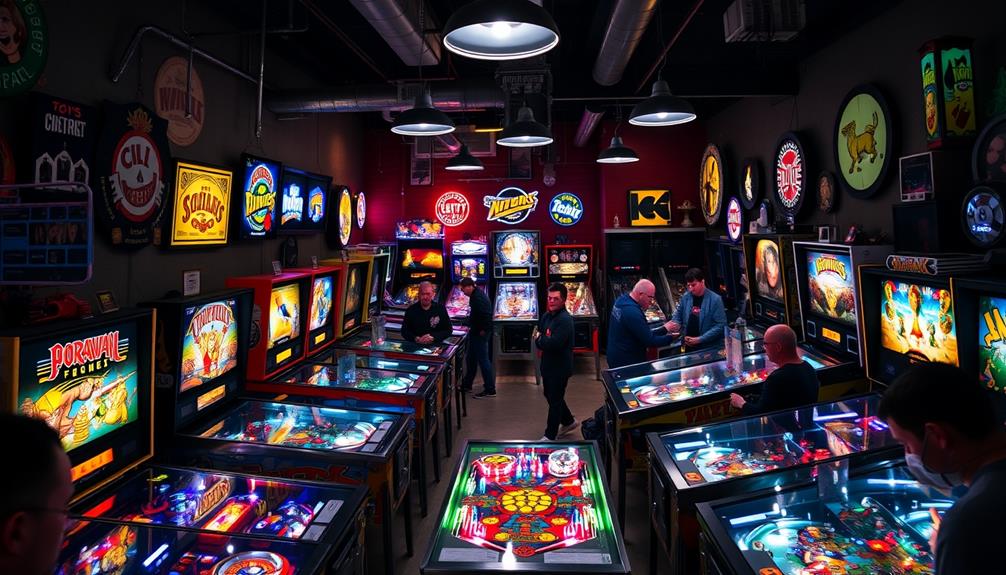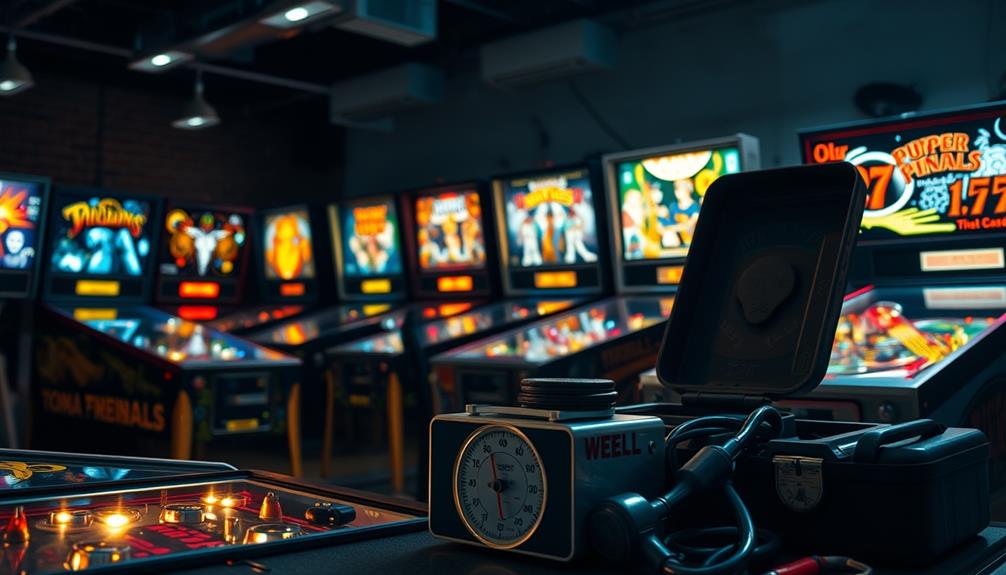Pinball was prohibited in numerous cities in the United States due to its association with organized crime and its perceived impact on young people. During the 1930s and 1940s, pinball was linked to gambling, leading to concerns about ethics and public safety. Mayor LaGuardia of NYC led a crackdown on the game, portraying it as a danger that corrupted youth and promoted criminal behavior. Sensationalized media coverage further fueled these fears, resulting in widespread bans in cities such as Chicago and Los Angeles. Despite experiencing a resurgence in the 70s, the negative reputation persisted for years. Stay tuned to learn how pinball eventually evolved into a legitimate recreational activity.
Key Takeaways
- Pinball was banned in the 1930s and 1940s due to its association with gambling and organized crime, leading to public fear and legal restrictions.
- NYC Mayor Fiorello LaGuardia's 1942 campaign intensified opposition by framing pinball as a corrupting influence on youth and a tool of mobsters.
- Media sensationalism linked pinball to juvenile delinquency, resulting in widespread societal stigmatization and bans in major cities like Chicago and Los Angeles.
- Pinball machines were exploited by organized crime for illegal gambling, raising community safety concerns and justifying legal prohibitions against the game.
- Legal reversals in the 1970s, recognizing pinball as a game of skill, led to its resurgence and modern acceptance as a legitimate form of entertainment.
Historical Background of Pinball
Pinball, once a popular amusement, faced significant backlash in the 1930s and 1940s, primarily due to its perceived ties to gambling. Many cities across the U.S. implemented a ban on pinball machines, fearing they encouraged gambling through their coin-in, coin-out operation. This concern heightened as New York City's Mayor Fiorello LaGuardia spearheaded an anti-pinball campaign, linking the game to organized crime and juvenile delinquency.
Within this framework, it's important to understand the negative impact of financial mistakes to avoid when engaging in activities perceived as gambling. In 1942, the ban on pinball was officially enacted in New York City, leading to police raids and the confiscation of over 2,000 machines. Demonstrations of destruction were held to illustrate the severity of the crackdown, fueling public fear.
Despite the introduction of skill-based features like flippers in 1947, the stigma surrounding pinball persisted throughout the 1940s and 1950s. Critics continued to view it as a moral menace, dismissing its evolving nature.
It wasn't until the 1970s that legal bans began to lift, culminating in the California Supreme Court ruling in 1974 that classified pinball as a game of skill. This pivotal decision marked a turning point, gradually shifting public perception and paving the way for legalization efforts.
The Rise of Pinball Machines

During the 1930s, a surge in pinball machine popularity transformed bars and amusement centers into vibrant entertainment hubs, particularly as people sought affordable amusements during the Great Depression. The first coin-operated pinball machine, Bally Hoo, debuted in 1931, capturing the public's interest and leading to widespread installations.
Initially, pinball machines lacked flippers, making them more akin to games of chance. This connection to gambling raised public concerns, especially in cities like New York, where the mayor linked these machines to organized crime and juvenile delinquency. As a result, many cities enacted bans on pinball machines by the mid-1930s.
The introduction of flippers in 1947 changed the game markedly, shifting the focus towards skill. However, the negative stigma surrounding pinball persisted due to its gambling associations.
Here's a quick look at the rise of pinball machines:
| Year | Key Event | Impact |
|---|---|---|
| 1931 | First coin-operated machine | Increased popularity |
| 1933 | Pinball in bars | Affordable entertainment |
| 1935 | Bans enacted | Backlash against gambling |
| 1947 | Flippers introduced | Shift to skill-based game |
| 1950s | Stigma persists | Ongoing public concern |
Legal Bans and Public Sentiment

As pinball machines gained traction in the post-war era, their reputation took a hit due to mounting legal restrictions and public outcry. Many cities across the U.S. banned pinball, associating it with organized crime and gambling. Mayor Fiorello LaGuardia led the charge in 1942, labeling pinball as a mob-controlled gambling racket. He oversaw the confiscation and destruction of thousands of machines, fueling a wave of legal prohibitions.
The cultural perception of games at the time was heavily influenced by concerns over youth engagement with what was viewed as potentially harmful entertainment, similar to how music therapy enhances emotional well-being through positive outlets.
Media sensationalism furthered public sentiment against pinball, linking it to juvenile delinquency. Civic groups, churches, and law enforcement rallied against these machines, creating a societal attitude that viewed them as harmful to community morals. Cities like Chicago and Los Angeles echoed this sentiment, enacting their own bans and reinforcing the stigma surrounding pinball.
Even after the introduction of flippers in 1947, which improved gameplay, authorities still saw pinball as a tool for illegal gambling. This reluctance delayed its eventual legalization in many regions until the 1970s.
The combination of legal restrictions and negative public perception kept pinball machines in the shadows for decades, shaping the narrative around this once-beloved pastime.
Organized Crime Associations

In the 1940s, pinball machines became a tool for organized crime, raising alarms about their role in illegal gambling and money laundering.
These machines weren't only a source of entertainment but also a means to engage in activities that undermined community safety, reminiscent of the issues surrounding mastering the art of bug out bags in preparedness.
You might be surprised to learn that mobsters allegedly used these machines to exploit youth and vulnerable populations, fueling concerns about juvenile delinquency.
As public fear grew, city leaders like Mayor LaGuardia labeled pinball as a "mob-controlled gambling racket," leading to widespread calls for its ban.
Gambling and Youth Influence
Many people don't realize the extent to which pinball machines were intertwined with organized crime, especially during the mid-20th century. As you look back at that era, it becomes clear that pinball wasn't just a game; it was a gambling racket that posed serious concerns for youth and public morality.
Law enforcement testimony from the 1940s revealed how mobsters exploited pinball for money laundering and illegal gambling, drawing in vulnerable citizens. The impulsive behaviors associated with gambling can be likened to those seen in individuals with Borderline Personality Disorder (BPD), where emotional dysregulation leads to risky choices.
Mayor Fiorello LaGuardia was particularly vocal about the dangers of pinball, labeling it a corrupting influence that contributed to juvenile delinquency. He argued that these machines led impressionable youth astray, fostering gambling habits that could ruin lives. The media sensationalized these fears, intensifying public outcry and prompting civic groups and parents to rally against pinball.
In response to this moral panic, cities like New York, Chicago, and Los Angeles enacted bans on pinball machines during the 1930s and 1940s. This widespread opposition reflected a collective concern about organized crime's influence and how it endangered the youth, ultimately leading to the game's infamous prohibition.
Mob Control and Operations
The connection between pinball machines and organized crime in the 1940s was undeniable, with mobsters leveraging these machines for illicit gains. During this period, pinball became a prime tool for illegal gambling and financial exploitation, drawing the attention of law enforcement and the public alike.
Some of the players involved in this underground world often exhibited inconsistent behavior and mixed signals, making it difficult for authorities to pinpoint their operations. Additionally, the charm and flattery used by mobsters often masked their ulterior motives, further complicating the landscape of pinball gambling recognizing relationship red flags.
Key factors contributing to the mob's control over pinball included:
- Money laundering: Mobsters used pinball machines to clean dirty money.
- Illegal gambling: These machines were often fronts for betting operations.
- Public sentiment: Many viewed pinball as a corrupting influence, especially on youth.
- Mayor Fiorello LaGuardia's efforts: LaGuardia campaigned against pinball, highlighting its ties to organized crime.
- Moral panic: The perception of pinball as a mob-controlled racket fueled widespread fear and backlash.
Despite the eventual legalization of pinball in the 1970s, the stigma from its organized crime associations lingered.
This historical connection shaped public perception for decades, leading to ongoing debates about gambling and morality in entertainment. Understanding this past helps you grasp why pinball once faced such fierce opposition.
Moral Concerns and Youth Impact

You might be surprised to learn how pinball games stirred up moral concerns in the 1940s, with many viewing them as gateways to gambling.
As concerns about the ethical implications of recreational activities grew, some argued that these games could lead to negative societal impacts, similar to those seen in discussions surrounding modern technologies, such as AI ethicist jobs.
Public outcry linked pinball to youth delinquency, prompting campaigns that aimed to protect schoolchildren from its perceived dangers.
With influential figures like Mayor LaGuardia labeling it a "mob-controlled gambling racket," the game quickly became a target for bans across various U.S. cities.
Gambling Association Concerns
Given the widespread association of pinball machines with gambling, concerns about their moral implications and impact on youth quickly escalated. Critics deemed the pinball industry a menace to society, believing it exploited vulnerable populations and contributed to juvenile delinquency.
The financial implications of such activities were also a point of concern, as they could lead to further issues within families and communities, similar to the challenges faced during a divorce process. New York City Mayor Fiorello LaGuardia took a firm stand, banning pinball in 1942 due to its links to organized crime and moral concerns.
The public's anxiety revolved around several key points:
- Pinball machines were often mistaken for gambling devices.
- Many viewed them as gateways to organized crime.
- The media sensationalized their connection to juvenile delinquency.
- Civic leaders campaigned to eliminate pinball from public spaces.
- Critics argued that pinball encouraged irresponsible behavior in youth.
These fears painted a grim picture of pinball as a threat to community morality.
The perception of pinball machines as vehicles for gambling and crime only intensified calls for their prohibition, contributing to a broader narrative that sought to protect the youth from perceived moral decay. By banning pinball, LaGuardia and others aimed to shield the community from these alleged dangers, reflecting societal fears of the time.
Youth Delinquency Links
Pinball's association with youth delinquency sparked significant moral concerns during the 1940s, as many believed these machines preyed on vulnerable children. Critics argued that pinball machines exploited kids financially and encouraged irresponsible behavior. Authorities, including law enforcement and civic groups, claimed pinball contributed to rising juvenile crime rates, leading to public outcry and demands for a ban.
Mayor Fiorello LaGuardia of New York City voiced these concerns, declaring pinball a corrupting influence on children, which ultimately resulted in a citywide ban in 1942. The media sensationalized these claims, framing pinball as a serious threat to schoolchildren's finances and moral upbringing.
To illustrate the impact of pinball on youth, consider the following table:
| Concern | Impact on Youth |
|---|---|
| Financial exploitation | Increased delinquency risks |
| Association with organized crime | Heightened moral panic |
| Loss of childhood innocence | Negative behavioral patterns |
Testimonies from figures like Kings County DA linked pinball to organized crime, further exacerbating fears about its influence on children and justifying legal prohibitions against the game.
Public Outcry Campaigns
The growing concerns over youth delinquency linked to pinball fueled a widespread public outcry that demanded immediate action. Civic groups, churches, and law enforcement rallied against what they viewed as a moral menace.
Mayor Fiorello LaGuardia took the lead in anti-pinball campaigns, framing pinball as a mob-controlled gambling racket that preyed on the vulnerable. These campaigns were bolstered by claims of pinball machines undermining community values and contributing to societal decay, reflecting a broader trend in content relevance and authority.
The media sensationalized these fears, increasing negative public sentiment and driving campaigns aimed at eradicating pinball from urban landscapes.
Here are some key points that illustrate the public response:
- Claims that pinball machines encouraged gambling and delinquency.
- Public demonstrations, including the destruction of pinball machines.
- Strict bans imposed in many cities, with hefty fines for violations.
- The wartime justification following Pearl Harbor, framing the ban as protective.
- Campaigns portraying pinball as a threat to social order and youth safety.
This combination of moral outrage and wartime justification cemented pinball's fate, as authorities sought to restore order and shield children from perceived dangers during a turbulent era.
Cultural Stigmatization of Pinball
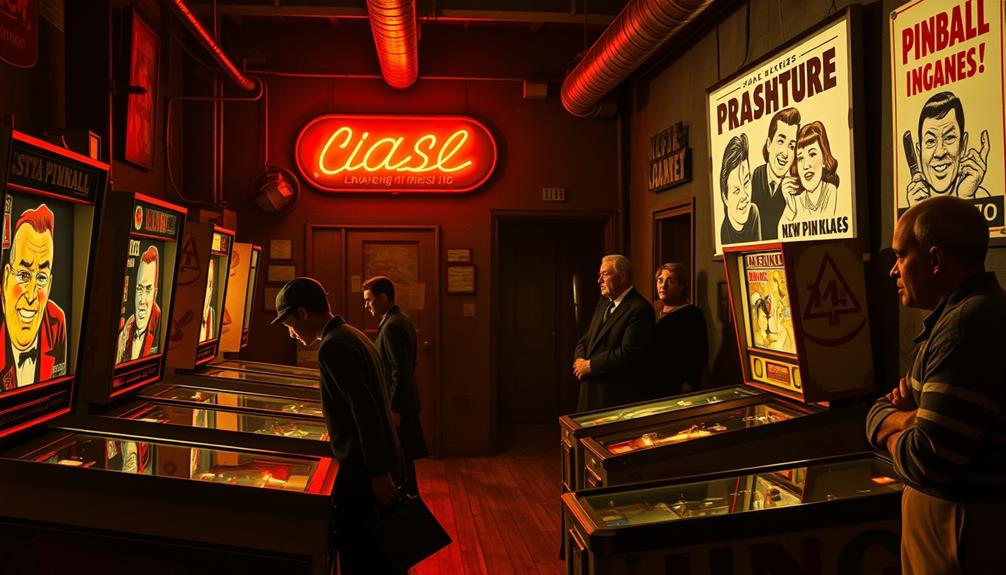
In the mid-20th century, pinball machines were often seen as harbingers of trouble, drawing the ire of parents and community leaders alike. The cultural stigmatization of pinball surged during the 1940s and 1950s, as the game became linked to juvenile delinquency and organized crime.
Media sensationalism amplified these fears, portraying pinball as a gateway to gambling and moral decay, much like how certain sectors face scrutiny in the private equity landscape due to increased focus on sustainability and responsible investing. Public figures, including New York City Mayor Fiorello LaGuardia, painted pinball as a mob-controlled racket that preyed on vulnerable citizens.
Despite the introduction of flippers in 1947, which transformed pinball into a skill-based game, the stigma didn't fade easily. Many people still viewed machines as tools for illegal gambling, fueling a moral panic that swept through communities.
Civic groups rallied against what they perceived as a threat to youth behavior, further entrenching negative perceptions.
However, as the years passed, the cultural landscape began to change. By the 1970s, attitudes toward pinball started to shift, leading to its eventual legalization.
This transformation marked a turning point, as the associations with gambling and crime gradually diminished, allowing pinball to reclaim its place in popular culture.
Key Events Leading to Bans

As fears about gambling and juvenile delinquency grew, pinball machines faced increasing scrutiny, leading to widespread bans across the United States. In the 1930s, the initial ban stemmed from pinball's association with gambling, particularly as early machines relied on luck rather than skill.
By 1942, New York City Mayor Fiorello LaGuardia intensified these efforts, linking pinball to organized crime. His campaign resulted in the confiscation and destruction of thousands of machines, igniting a wave of public opposition. The perception of pinball as a hazardous pastime was exacerbated by social concerns over the increasing cost of recreational activities, much like the awareness surrounding toilet maintenance and repairs that can lead to higher expenses if ignored.
Several key events contributed to the bans:
- Media sensationalism fueled fears of pinball as a corrupting influence on youth.
- The political climate, influenced by World War II, justified stricter regulations on recreational activities.
- Other cities like Chicago, Los Angeles, and Milwaukee soon enacted similar bans.
- Local governments aimed to curb juvenile delinquency by eliminating perceived vices.
- The moral panic surrounding gambling led to widespread societal acceptance of the bans.
These events collectively shaped the perception of pinball, transforming it from a popular pastime into a targeted activity associated with crime and moral decay.
Legal Reversals in the 1970s

By the 1970s, attitudes toward pinball began to shift dramatically, paving the way for legal reversals that would reshape its status. In 1974, the California Supreme Court ruled that pinball was a game of skill rather than chance. This landmark decision sparked legal challenges against the existing ban on pinball in various cities.
In April 1976, Roger Sharpe demonstrated his pinball skills before the New York City Council, which played a vital role in overturning the city's ban later that year. The New York City Council recognized the potential economic benefits of legalizing pinball, projecting an estimated $1.5 million in licensing revenue.
This change reflected a broader transformation in public perception; pinball was no longer seen merely as a gambling activity but as a legitimate form of entertainment. Following New York's legalization, cities like Chicago began to relax their restrictions on pinball machines, further solidifying its resurgence.
These legal reversals not only marked a significant turning point for pinball but also illustrated how shifting attitudes could lead to substantial changes in law and culture.
Resurgence and Modern Acceptance
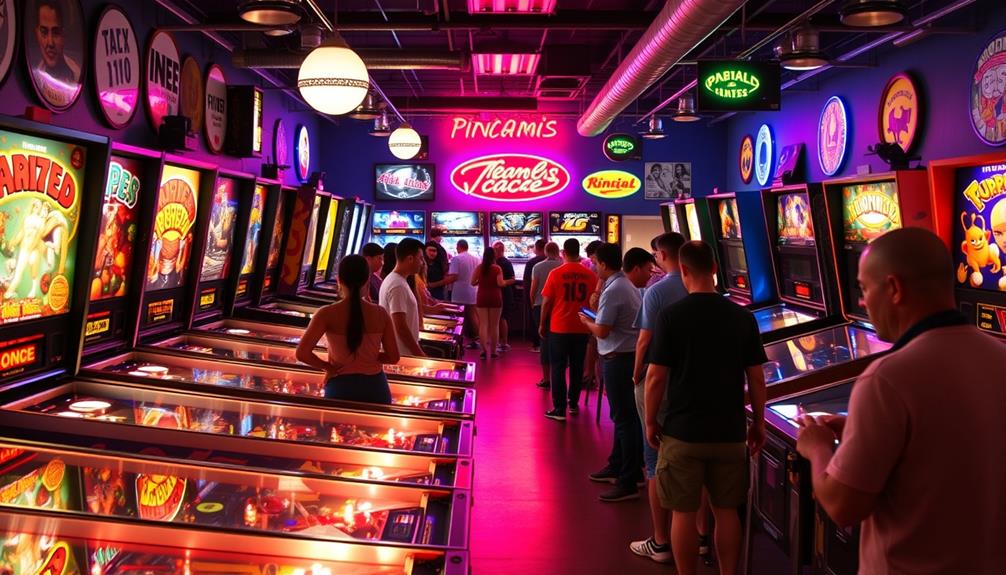
The resurgence of pinball in recent decades has transformed it into a beloved pastime, drawing in a diverse crowd of players and enthusiasts. The cultural shift that began in the 1970s recognized pinball as a game of skill, rather than mere chance, with pivotal moments like the California Supreme Court ruling and Roger Sharpe's demonstration of skill-based gameplay. This laid the groundwork for modern acceptance.
Today, you can see the vibrant pinball scene flourish through:
- Over 1,800 events annually hosted by the International Flipper Pinball Association
- Advanced technology and themes in modern pinball machines that attract new players
- Community engagement through leagues and events that foster connections among enthusiasts
- A sense of belonging fueled by resources like the Pinball Map app
- The growing popularity of competitive leagues that keep the spirit of pinball alive
With these elements combined, pinball has successfully moved past its history of banning pinball and emerged as a respected and cherished activity in contemporary culture.
The community's passion and dedication guarantee that this resurgence will continue to thrive for years to come.
Frequently Asked Questions
Where Is Pinball Still Illegal?
Pinball's still illegal in places like Ocean City, New Jersey, where it's banned on Sundays, and Grove City, Ohio, which has enforced its ban since 1974. Some areas maintain outdated laws against the game.
Why Was Pinball Banned in NYC?
You might wonder why pinball faced a ban in NYC. Mayor LaGuardia believed it fostered crime and exploited citizens, leading to a crackdown that saw thousands of machines confiscated and destroyed in a public display. This was not the first time pinball had been banned in a major city. In fact, the history of pinball prohibition dates back to the early 20th century, with many cities labeling it as a form of gambling and a contributing factor to juvenile delinquency. The ban in NYC was just one chapter in the ongoing saga of pinball’s legal battles.
Why Was There a 35 Year Ban on Pinball?
Imagine vibrant arcades buzzing with excitement, yet for 35 years, pinball's allure vanished under a shroud of suspicion. You see, authorities believed it fueled crime and chaos, leading to a dramatic, long-lasting prohibition.
Why Were Pinball Machines Illegal in California?
Pinball machines were illegal in California because they were seen as gambling devices. Authorities believed they encouraged chance over skill, raising concerns about youth gambling and contributing to juvenile delinquency and broader moral issues of the time.
Conclusion
In the end, pinball's journey from banishment to beloved pastime shows how society can change its views. Once seen as a menace, it now lights up arcades and homes, just like your favorite video game. The battles over morality and crime may have seemed insurmountable, but they paved the way for pinball's resurgence. So, next time you hear that iconic "ding," remember the wild ride it took to get there. Keep flipping those flippers!
